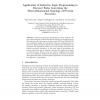122 search results - page 18 / 25 » Protein Fold Recognition using Residue-Based Alignments of S... |
BMCBI
2006
13 years 7 months ago
2006
Background: In order to maintain the most comprehensive structural annotation databases we must carry out regular updates for each proteome using the latest profile-profile fold r...
CSB
2003
IEEE
14 years 26 days ago
2003
IEEE
Recognition of a protein’s fold provides valuable information about its function. While many sequence-based homology prediction methods exist, an important challenge remains: tw...
ILP
1998
Springer
13 years 11 months ago
1998
Springer
Abstract. Inductive Logic Programming (ILP) has been applied to discover rules governing the three-dimensional topology of protein structure. The data-set unifies two sources of in...
BMCBI
2004
13 years 7 months ago
2004
Background: Hidden Markov Models (HMMs) have proven very useful in computational biology for such applications as sequence pattern matching, gene-finding, and structure prediction...
BMCBI
2007
13 years 7 months ago
2007
Background: Our goal is to develop a state-of-the-art protein secondary structure predictor, with an intuitive and biophysically-motivated energy model. We treat structure predict...


